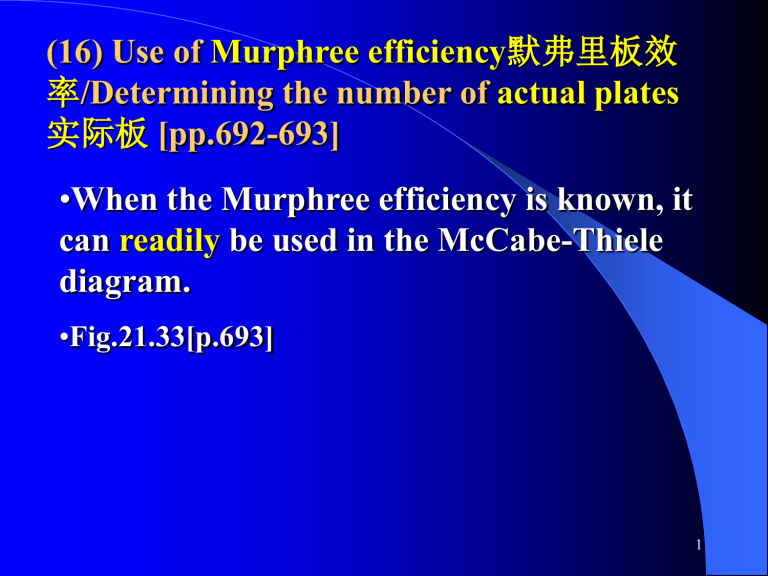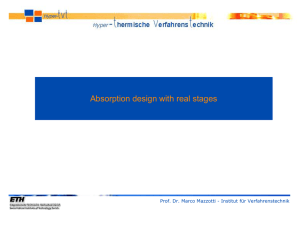PowerPoint 演示文稿
advertisement

(16) Use of Murphree efficiency默弗里板效 率/Determining the number of actual plates 实际板 [pp.692-693] •When the Murphree efficiency is known, it can readily be used in the McCabe-Thiele diagram. •Fig.21.33[p.693] 1 Fig.21.33 True equilibrium curve Effective equilibrium curve y y n n c yn d ye yynn e yn b y n 1xFyn 1 a yn1 x x B xF ab xyB nx1xByn 1 yn M x y1xF y F y y ac yn y n y n x1 n x F n 1 t1 x D xD z y n yn 1 yn.70) yn ( 21 yn y yn 1 Mx(2 xyDn yn 1 ) n yn xB yn 1 y.n70 y 1 ye y ( y y ) ( 21 ) 2 M e t xn 1 1 yn 1 t2 x x x F B B M Murphree plate efficiency x2 xn xB xD x F xn yn 1 2 y 3 x y x x •Triangle acd represents the ideal plate and triangle abe the actual plate. •The actual plate, instead of enriching the vapor from yn+1 to y*n, accomplished a lesser enrichment yn- yn+1. 3 ab yn yn 1 M ac yn yn 1 yn yn 1 M ( y yn 1 ) ye y M ( ye y ) n (21.70) (21.70) M Murphree plate efficiency •To apply a known Murphree efficiency to an entire column, it is necessary only to replace the true equilibrium curve ye versus xe by an effective equilibrium curve y’e versus xe, whose ordinates are calculated from the equation (21.70). 4 •How to plot the effective equilibrium curve? •Giving xn, find y*n from equilibrium curve and yn+1 from operating yn from equation yncalculate ab ynline, 1 M (21.70), then plot point (xn, yn) … ac yn yn 1 yn yn 1 M ( yn yn 1 ) ye y M ( ye y ) (21.70) (21.70) M Murphree plate efficiency •How to determine the number of actual plates? •The reboiler is not subject to a discount for plate efficiency, and the true equilibrium curve is used for the last step in the stripping section. 5 Effective xD curve equilibrium True equilibrium curve xD xF xD xB xF How many xF actual plates xB are needed in the1left N actual 6.7 construction? M N 3 plus a reboiler N actual 6.7 xB 1 1 M 5.2 plates plus a N actual 6.7 5.2 plates plus a reboileer xD M xF xB xD xF xD 6 Effective equilibrium curve True equilibrium curve xD How many actual plates are needed in the left construction? xF xBxD N actual xF 5.3 plates plus a reboiler N xBfractional 3 plus a actual reboilerplate, then No N actual 6 plates plus a reboiler N 3 plus a reboiler 7 •Murphree efficiency can be different from individual plates, and this is more accurate to calculate the number of actual plates than by overall efficiency of a column全塔效率. 8 3. BATCH DISTILLATION (间歇精馏 ) [pp.700-703] 1)Simple Distillation简单蒸馏(自学) • (1)Flow diagram (Refer to Fig.21.37) Cooling water Condenser x0 ( xF ), n0 ( F ) L L dL y dn Batch Feed 间歇进料 x 釜液 W n n xdn 2 y dD Still L L dL Product 冷凝器 yreceiver 冷却水 dD 馏出液 HeaterPrDoduct Bottom n1 B xx1 xB y x Dm 9 •There are many cases where batch distillation间歇精 馏 is preferred, particularly in the food and pharmaceutical industries. Batch distillation is used when small amounts of product are made in a pilot plant to provide samples for product sampling or testing. •Features: 1)Unsteady state; 2)Without reflux; 3)Onestage partial vaporization process. The vapor leaving the still at any time is in equilibrium with the liquid in the still. [y is in equilibrium with x.] 10 Cooling water Condenser x0 ( xF ), n0 ( F ) L L dL y dn Batch Feed x 釜液 W n n xdn 2 y dD LProduct L dL 冷凝器 yreceiver 冷却水 dD 馏出液 HeaterPrDoduct Bottom n1 B y xDm xx21 xB 11 (2)Rayleigh equation (瑞利方程) L L dL At a given time, n A nx (21.80) dn A d ( xn) ydn ndx xdn ydn y dn x 釜液 W Heater L加热 L n n xdn 2 dn dx n1 (21.82) y n yx x1 dD n1 dn x1 dx n1 (21.83) 釜液 釜液 n0 n x0 y x ln n0 W W Eq.(21.83) is known as the Rayleigh equation. dx/(y-x) x2 can be integrated graphically or numerically using x2 equilibrium data (y~x equilibrium relationship). 12 (3) For an ideal mixture, That is, yyyAAA AB xxxAAA yyyAB AB xAB AB x x B y B AB xBB AB x A yA 1 ( AB 1) x A 21..84 84)) (((21 21 .84) (21.84) ynnBA xx A xB dn dn dn A,, yy Bdn dn dn dnB Because n AA x AA ,,, yyyAAdn dn nnnAB xxxAB A dn AA , y BBdn dnBB nBB xBB , y A dn dn A , y B dn dnB ndn dn dn dn A nA B A //x B dn dn n dn AA / dn dn AA y AAB A n A AB dnAB///dn dn dn dnAB AB nnn dn B dn dn dn A B dnBB / dn dnBB yAB nB B dn nB dnBA/ dn dn dnBB dn dn dn AA AB dnBB (21 21..85 85)) ( AB ( 21.85) AB n n dn dn n AAAA nBBB n n (21.85) or AB n A nnn A nB nnnB A ln ln 21...86 86))) A BB AB ln ln 21 86 ln ln (((21 AB AB 13 dn A dnB AB (21.85) Afternintegration nBbetween limits A nA nB ln AB ln n0 A n0 B (21.86) 1 / AB nB n A n0 B n0 A (21.87) 14 Number of moles of product: D Average concentration of product: y xDM F D B or n0 D n1 D F B And FxF Dx Dm Bx B, x0 xF , x1 xB , y xDm n1 y x0 ( x0 x1 ) n0 n1 EXAMPLE 21.9. 15 Advantages. The advantages of batch distillation are that several products can be made from a single unit, and can effectively handle sludges and solids. Disadvantages. For a given product rate, the equipment is larger. It requires more operator attention, uses more energy, and because it is a dynamic process, is harder to control and model. 16 2)Batch Distillation with reflux间歇精馏/有回流 的间歇蒸馏 [pp.702-703] • In many cases, a rectifying column with reflux is used to improve the performance of the batch still. • Flow diagram. • Features: Unsteady state; Only rectifying section in the column. Product concentration differs from different operations. 17 • Two basic operation methods: • (a). Keep the top composition (xD) constant by increasing the reflux ratio as the composition of the liquid in the reboiler changes. • (b). Fix the reflux ratio and let the overhead product purity vary with time, stopping the distillation when the amount of product or the average concentration in the total product reaches a certain value. (某个) 18 • Calculation and analysis for the operation of a distillation column. • The plate column has been established, and the following data are given: Equilibrium relationship; xF; q; N and M (Nactual). • In order to obtain overhead and bottom products with required mole fractions of xD and xB, the reflux ratio RD and the feed plate position must be determined. • Calculation method: Trial and error(反复试验). 19 • Attentions of Operation analysis of distillation column: (a) Suitable feed plate position; (b) Keep material balance: If D and B changed, xD and xB will be changed too. (c) Reflux ratio is the key measure of controlling product quality. [For example, if N is given, RDxD, xB .] (d) If xF changed, feed plate position should be changed too. 20 4. AZEOTROPIC AND EXTRACTIVE DISTILLATION [pp.131](恒沸精馏和萃取精馏) • When relative volatility near or equal to unity, the separation of components is difficult by conventional distillation, or impossible because of azeotrope恒沸混合物 formation. • Basic principles of azeotropic and extractive distillation: Adding a third component(solvent) to increase the relative volatility of the original components, so that the mixtures with relative volatility near or equal to unity can be separated by conventional distillation. (相对挥发度) 21 (1) Azeotropic distillation恒沸精馏 • Materials called entrainers(夹带剂)(third component) are added to the original mixture, and usually a new azeotrope with lowest-boiling points 有最低恒沸点的恒沸物 is formed. The new azeotrope will of course contain one or more of the feed components, and leaving behind component(s) which may be recovered in the pure state. • Example: Recovery and purification of ethanol and water. Flow diagram… • Selection of entrainers. 22 (2) Extractive distillation萃取精馏 • A solvent is added to the distillation tower to increase relative volatility of key components in the feed mixture. The effective extractive solvent萃取剂 will selectively interact with one (or more) of the components, thereby increasing relative volatilities. • Example:Use of furfural糠醛 to permit the separation of butadiene丁二烯 from a mixture containing butane丁烷 and butenes丁烯. Flow diagram… • Selection of extractive solvents. 23









